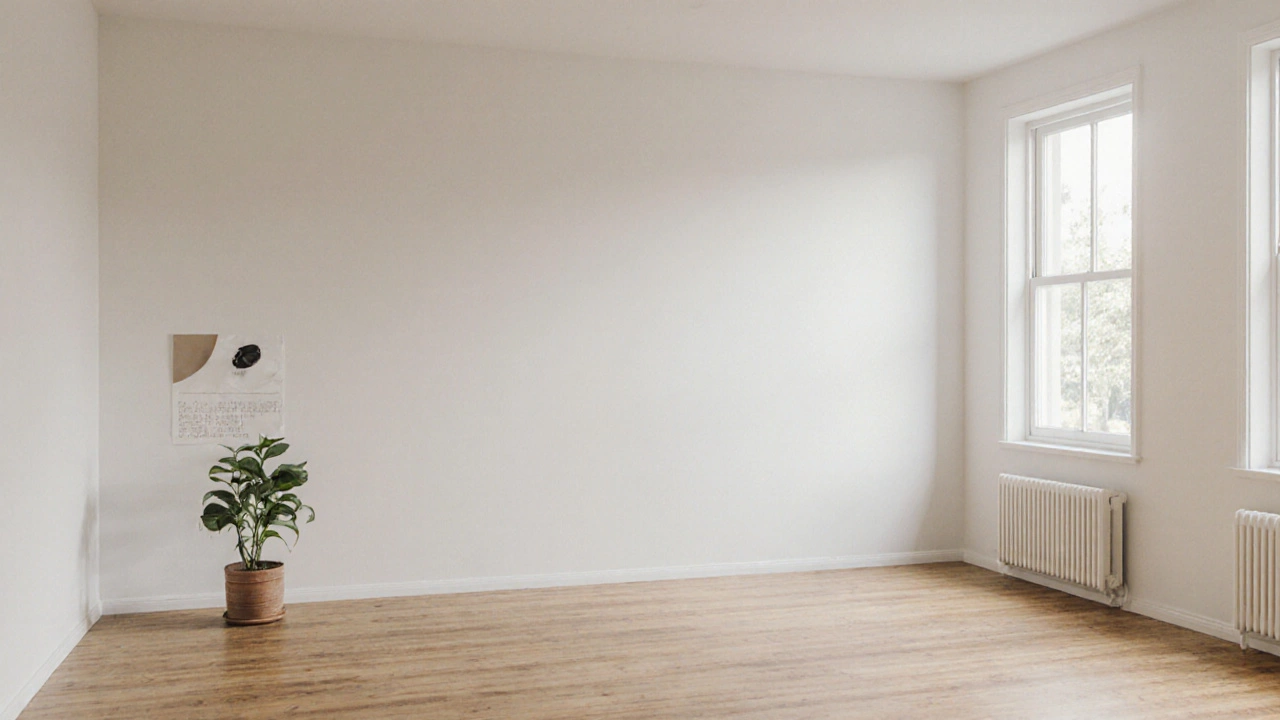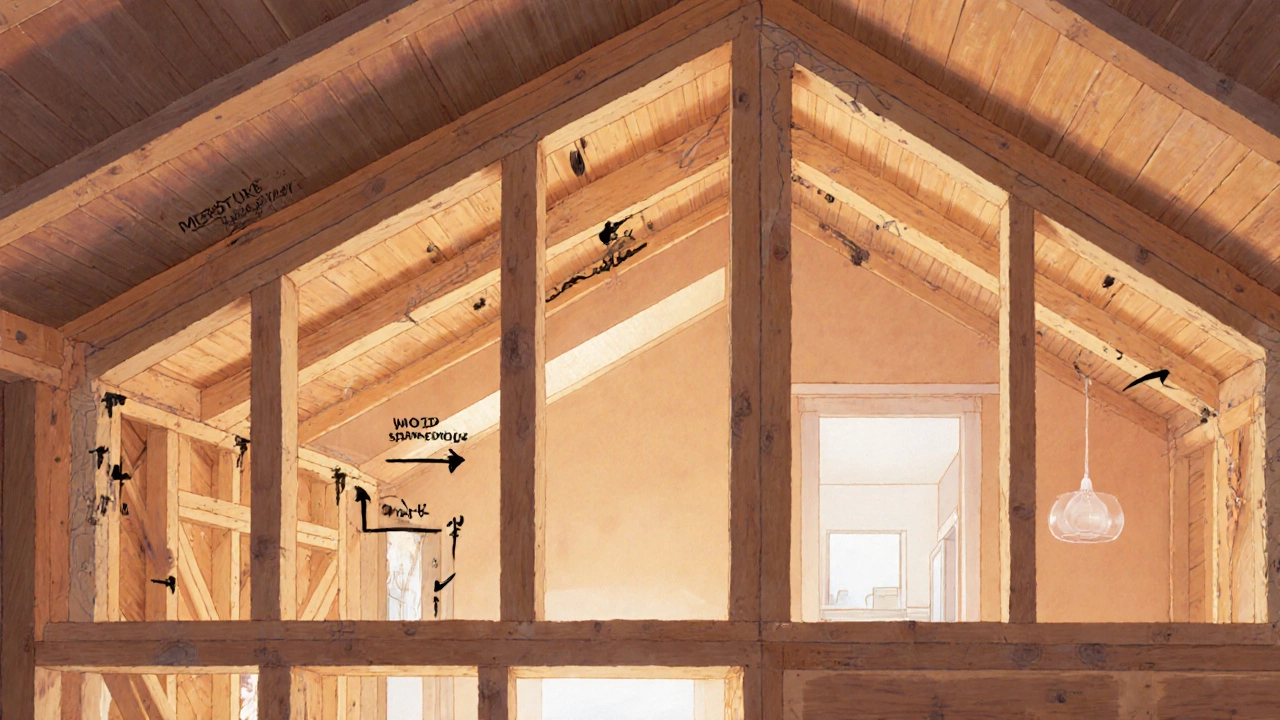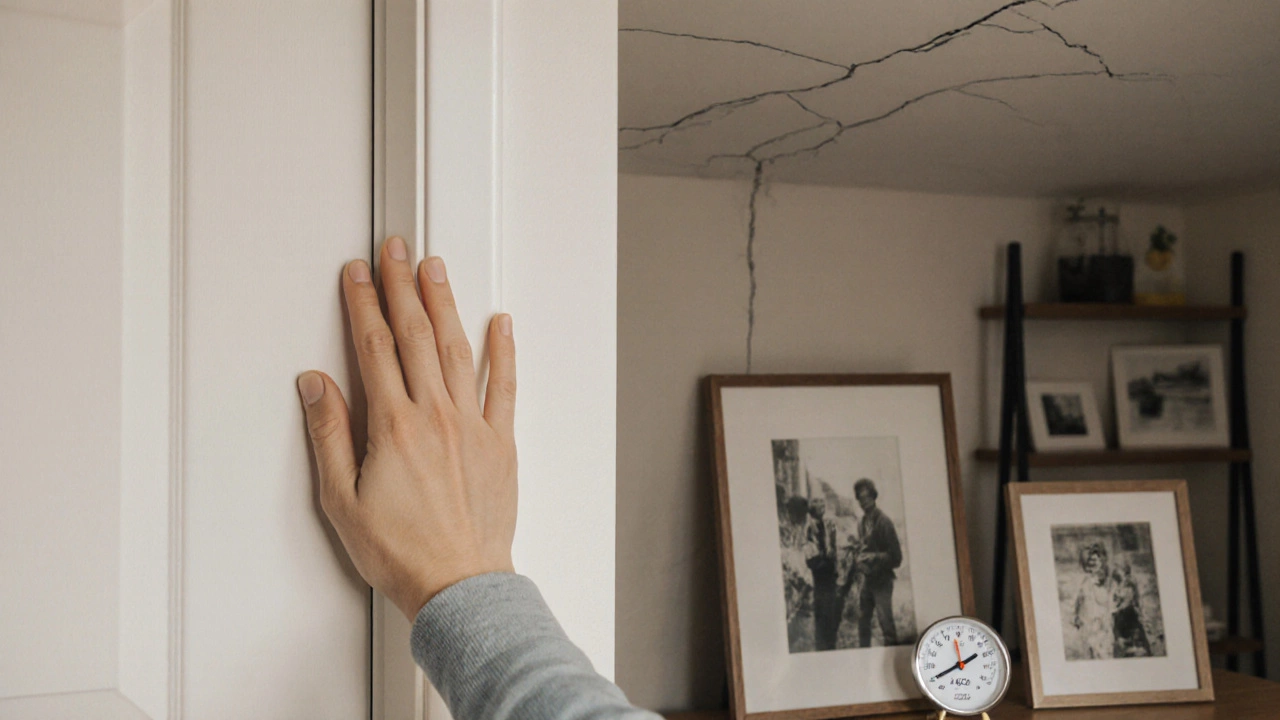Why Can't You Decorate a New Build Right Away?
 Nov, 11 2025
Nov, 11 2025
New Home Settling Time Estimator
Results will appear here after calculation.
You just got the keys to your brand-new home. The walls are white, the floors are clean, and everything smells like fresh paint and sawdust. You’re excited. You’ve been dreaming of this moment for years. So you head to the store, pick out your favorite rug, hang up those framed photos, and start arranging the furniture. But then your builder calls. "Hold off on decorating," they say. "Wait at least six months."
Why? It’s not about being difficult. It’s not about control. It’s about physics, chemistry, and the quiet, slow process of a house settling into itself.
New builds aren’t finished when the last nail is hammered
A new build looks complete on the outside. But inside, it’s still changing. The timber framing is drying out. The plaster is curing. The concrete slab is shrinking. Even the insulation is releasing moisture trapped during installation. All of this creates movement - tiny shifts in the structure that you can’t see, but that will show up in your walls and ceilings.
Think of it like baking a cake. You take it out of the oven, and it looks done. But if you cut into it right away, it collapses. You have to let it cool. A new house needs the same patience. The first six to twelve months are the most critical. That’s when most of the movement happens.
Cracks aren’t always your fault - they’re building science
You might notice hairline cracks along the ceiling corners or near door frames. You think, "I must have hung something too heavy." But you didn’t. That’s just the house settling. Timber frames lose moisture over time and shrink. Plaster and drywall crack where they meet different materials - like where the ceiling meets the wall. These aren’t signs of poor workmanship. They’re normal.
In New Zealand, where timber-frame homes dominate, this is especially common. The climate here - wet winters, dry summers - makes wood expand and contract. Even high-quality kiln-dried timber can still lose up to 5% of its moisture content in the first year. That’s enough to pull drywall away from the frame and create gaps.
Painting over these cracks too early? You’re just hiding them. They’ll come back. And when they do, you’ll have to repaint the whole wall. Worse - if you’ve already hung wallpaper or expensive artwork, you’ll risk damaging them.
Builders’ warranties depend on timing
Most new builds in New Zealand come with a 10-year builder’s warranty under the Building Act 2004. But that warranty only covers defects that arise from poor workmanship or materials. If you decorate too soon and cause damage - like pulling plaster away with heavy shelves or forcing a door open because it’s sticking - you could void your claim.
Let’s say you install a heavy TV mount on a wall that’s still shifting. Six months later, the mount pulls away, and the wall cracks. The builder says, "This isn’t a construction defect - you installed something too soon." And they’re right. The warranty won’t cover it.
Same goes for built-in wardrobes, floating shelves, or even large mirrors. If they’re fixed to walls that haven’t stabilized, they’ll pull away, crack the plaster, or warp the frame. Builders expect you to wait. That’s why they leave the house in a "shell" state - bare walls, no fixtures, no heavy items.

What you can do while you wait
You don’t have to sit around doing nothing. There are smart, low-risk ways to make your new house feel like home while you wait for the structure to settle.
- Hang lightweight, removable decals or peel-and-stick wallpaper. These won’t damage walls and can be removed easily.
- Use freestanding furniture - no need to screw anything into walls yet.
- Bring in plants, rugs, and curtains. These add warmth without stressing the structure.
- Take photos of any small cracks or gaps as they appear. Write down the date. This helps later if you need to make a warranty claim.
- Open windows daily for the first few months. Good airflow helps moisture escape faster.
Some people use a hygrometer to track humidity levels. If indoor humidity stays above 60% for weeks, it means the house is still releasing moisture. Wait until it drops below 50% before committing to permanent decor.
When is it really safe to decorate?
There’s no magic date. But here’s what most experienced builders in Wellington recommend:
- First 3 months: Focus on ventilation. Keep windows open. Use dehumidifiers if needed. Don’t install anything fixed to walls.
- Months 4-6: Start testing for movement. Gently press on walls near door frames. If they feel solid and don’t flex, you’re getting closer. Check for new cracks. If none have appeared in the last 30 days, you’re in good shape.
- Month 6-12: This is the sweet spot. Most structural movement has slowed. You can now hang pictures, install shelves, and fix light fixtures. Still avoid heavy items like large TVs or built-in cabinets until the 12-month mark.
Some builders suggest waiting a full year - especially if you live in a region with high rainfall or extreme temperature swings. In places like Nelson or West Coast, where humidity is high year-round, waiting 12-18 months isn’t unusual.

What happens if you ignore the advice?
You might get away with it. Some people hang their art right away and never see a crack. But you’re gambling. Here’s what can go wrong:
- Paint peels in lines - not from bad paint, but from wall movement.
- Doors stick or won’t close - because the frame shifted.
- Tile grout cracks in bathrooms - because the subfloor settled unevenly.
- Your expensive wallpaper lifts at the seams - because the wall behind it moved.
- Your builder refuses to fix damage because you "interfered with the structure."
One client in Lower Hutt installed a full-height bookshelf against a wall in month two. By month eight, the shelf had pulled the drywall away by 5mm. The wall cracked. The shelf was crooked. The builder said, "That’s not a defect - you installed it too soon." Repair cost: $4,200. All because they didn’t wait.
It’s not about control - it’s about respect
Building a house isn’t like assembling IKEA furniture. It’s a living system. Wood breathes. Concrete hardens. Insulation dries. And all of it moves - slowly, quietly, and without warning.
Waiting to decorate isn’t a punishment. It’s a sign of respect for the craftsmanship that went into your home. It’s about giving the structure time to become what it was meant to be. A stable, quiet, lasting home.
When you finally do hang that first picture - after six months, after the cracks have stopped appearing, after the walls feel solid - it won’t just look good. It’ll feel right. Because you didn’t rush it. You let your house grow into itself.
Can I paint the walls right after moving in?
It’s better to wait at least six months. Fresh plaster and drywall need time to fully cure and release moisture. Painting too early can trap moisture, leading to peeling paint, mold, or cracking. If you must paint, use a breathable, vapor-permeable paint and only after humidity levels have dropped below 50% for several weeks.
What if I see cracks after I’ve already decorated?
Small, hairline cracks are normal in the first year. If they’re under 2mm wide and don’t grow, you can fill them with flexible filler and repaint. But if cracks are wider than 5mm, appear suddenly, or run diagonally across walls, contact your builder immediately. These could indicate structural movement that’s still active - and might be covered under warranty.
Is it okay to install floating floors right away?
Yes - floating floors like laminate or engineered wood are generally safe to install after 3-4 months. They’re not fixed to the subfloor, so they can move with the house. Avoid glued-down hardwood or tile until the 12-month mark, as these are rigid and can crack if the subfloor shifts.
Why do builders leave the house empty?
Builders leave homes empty to avoid damage during the settling phase. Heavy furniture, shelves, and fixtures can cause stress on walls and floors that are still moving. An empty house also makes it easier to inspect for defects, monitor moisture levels, and complete final inspections without interference.
Does the season I move in affect how long I should wait?
Absolutely. Moving in during winter? Moisture takes longer to dry out. Moving in during summer? Faster drying, but heat can cause timber to expand quickly. In New Zealand, homes built in autumn or winter often need longer - up to 12 months - because they’re drying out through the damp months. Spring-built homes may stabilize faster.
